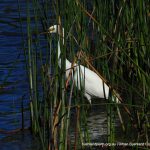Herdsman Lake Regional Park

Herdsman Lake Regional Park, 7 km northwest of the CBD, is Perth’s largest inner metropolitan wetland and consists of permanent water bodies, seasonally dry wetlands and open parklands. It is part of a narrow chain of wetlands that extends parallel to the coast from Yanchep in the north to Mandurah in the south in the Spearwood Dune System.
It is an extremely important wetland on the Swan Coastal Plain as it supports a wide diversity of wildlife species; serves as an important bird breeding ground and is a summer refuge for transequatorial migratory birds. Herdsman Lake is a Bush Forever site. Download Listing.
Herdsman Lake contains an inner wetland (approximately 160 hectares in area) which is dominated by Bulrush (Typha orientalis) and a dredged outer moat consisting of four deep permanent water bodies (Floreat Waters, Popeye Lake, Powis Lake and Floreat Lakes joined by small channels restricting access to the central conservation area.
Start your visit to Herdsman Lake at the Herdsman Lake Wildlife Centre at the southern end on the corner of Selby & Flynn St, Wembley or at the northern car park near Selby Street North and Jon Sanders Drive, Herdsman. Scenic views over the wetland can be enjoyed from the Wildlife Centre, while observation of wildlife on the open water can be made from two bird hides and most sections of the Lake’s edge.
Park Vegetation

The vegetation types in the Park are primarily wetland communities that are either sedgelands dominated by Typha orientalis or woodlands with an overstorey of either Melaleuca rhaphiophylla, Eucalyptus rudis, or Eucalyptus camaldulensis. (Note that Eucalyptus camaldulensis is not a naturally occurring species at this location).
The wetland communities in the Park are influenced by, and are dependent on, the hydrological zones within the lake system. Sedgeland communities dominate the fringing open-water areas; the wet-forest and woodland communities are in the seasonally inundated margins between the open water and the dryer recreation areas.
The native sedgeland communities throughout the Park extend into the understorey of the forest and woodland. By contrast the Typha orientalis communities only occur where there is no shading overstorey.
The vegetation of Herdsman Lake has changed a great deal since European settlement. Reports by early European settlers describe the Lake as an area of open water with fringing rushes and fresh water paperbarks (Melaleuca rhaphiophylla) giving way to swamp banksia (Banksia littoralis) and flooded gum (Eucalyptus rudis) with an understorey of shrubs.
Herdsman Birdlife

Herdsman Lake contains one of the most varied and easily observed waterbird fauna of any Lake in southwestern Australia due primarily to its wide range of habitats including: deep, open water (approx. 1.5 – 2.5 metres); shallow water, seasonally inundated areas (including mud flats and sedge lands); grassy banks of drains and the shoreline; dense stands of rushes; and trees.
It is an important breeding site with at least 20 species, including Black Swan, Australasian Swamphen, Little Grassbird and Australian Reed-Warbler. Areas in the central wetland in summer provide habitat for bird species such as White-fronted Chat and Australian Pipit, while in winter, these areas are covered by deeper water and are used by ducks and other water birds.
Two species recorded at the Park, Australasian Bittern and Peregrine Falcon, are listed as specially protected under the Wildlife Conservation Act 1950. From a conservation viewpoint, the presence of Buff-banded Rail, Baillon’s Crake, Australian Spotted Crake and Spotless Crake is important (Curry, 1981).
A number of migratory birds listed under the Japan- Australia Migratory Birds Agreement (JAMBA) and the China-Australia Migratory Birds Agreement (CAMBA) have been sighted at the Park.
It is one of the few wetlands in southwestern Australia where Australian Little Bittern breed. Another three bird species which are rarely found breeding in the southwest, Blue-billed Duck, Hardhead and Australasian Shoveler nest at Herdsman Lake.

Particularly visible are the three grebe species – the Australasian Grebe, Hoary-headed Grebe and Great Crested Grebe – which construct floating nests on the open water. Eurasian Coot also breeds in abundance.
Pink-eared Duck, Musk Duck and Dusky Moorhen are also present at the Lake. Freckled Duck also occasionally occur.
Herdsman Lake is also used regularly by small numbers of freshwater migratory waders such as Sharp-tailed Sandpiper, Common Greenshank, Wood Sandpiper and Long-toed Stint (Curry, 1981). Long-toed stint is uncommon in the area and it’s occurrence at Herdsman Lake is significant.
Several Australian waders also occur in the Park and four of them – Black-fronted Dotterel, Red-kneed Dotterel, Red-capped Plover, and Pied Stilt have been recorded as breeding at the Lake.
A list of birds seen at this location can be found here.
Cultural Heritage
Stone chips and flakes found on the higher ground to the north of Herdsman Lake indicate past Aboriginal use. Aboriginal people call the area Ngurgenboro and used it as a food source.
Further Information
The material presented here is sourced from the Herdsman Lake Regional Park Management Plan 2004 – 2013.
For a more extensive Image Gallery of Perth’s waterbirds visit our Wetland Birds page.













